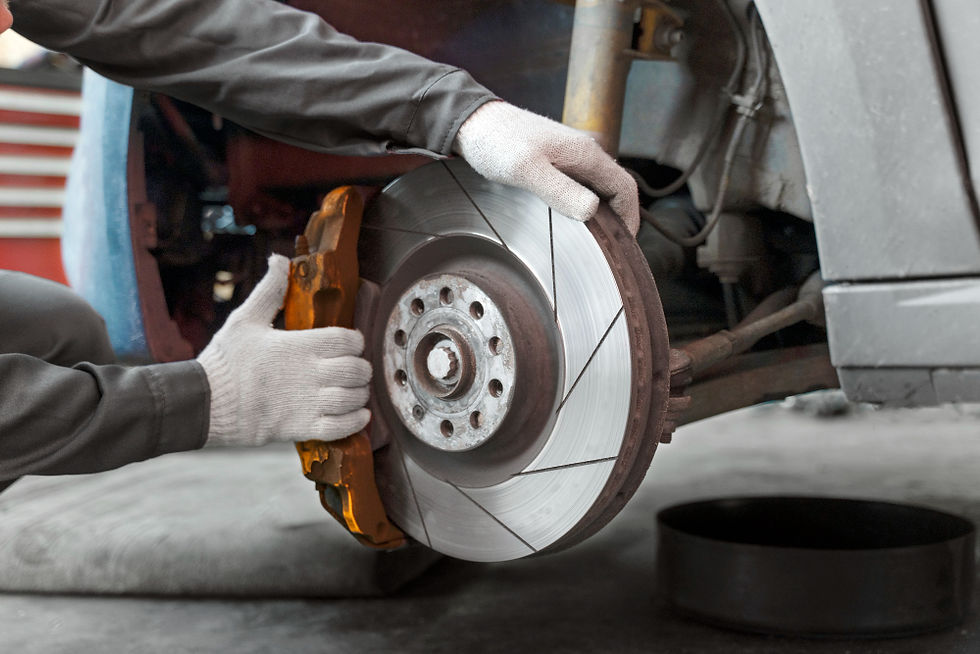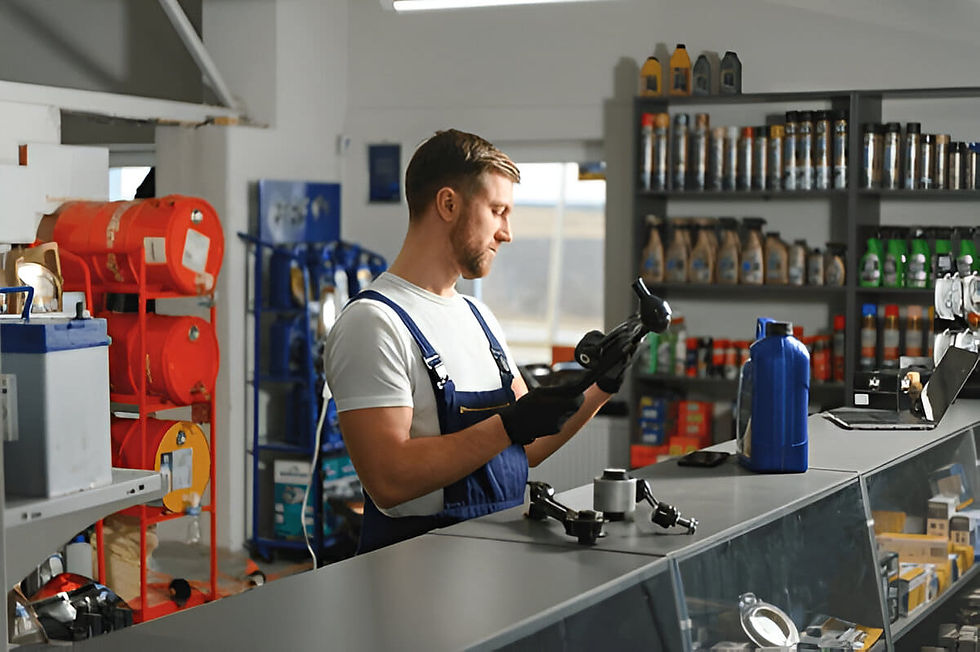Why Your Car Brake Choice Matters More Than You Think
- Molly Crowe
- Sep 4
- 7 min read
Updated: Nov 20
Have you ever wondered why some cars seem to stop on a five-cent piece whilst others feel like they're sliding on ice? What if I told you that choosing the right brakes could be the difference between a close call and a serious accident? And here's something that might surprise you - did you know that the wrong brake choice could actually cost you more money in the long run?
Your car's brakes are arguably the most critical safety component in your vehicle. They're the unsung heroes that work tirelessly every time you press that pedal, converting your car's kinetic energy into heat through friction. Yet many drivers treat brake selection as an afterthought, opting for whatever's cheapest or simply letting their mechanic decide without much input.

This guide will walk you through everything you need to know about selecting the perfect brakes for your vehicle. We'll explore how to match brake components to your specific driving needs, navigate the sometimes confusing world of OEM versus aftermarket parts, and help you understand which brake pad materials work best in Australian conditions. You'll also learn about rotor options, when to tackle installation yourself versus calling in the professionals, and how to spot the warning signs that your brakes need attention. By the end, you'll have the knowledge to make an informed decision that keeps you safe and your wallet happy.
Understanding Your Vehicle's Specific Brake Requirements
What Type of Braking System Does Your Car Have?
Before you even start shopping for brake components, it's vital to understand what type of braking system your vehicle uses. Most modern cars feature disc brakes on all four wheels, but older models and some budget-friendly vehicles might still have drum brakes on the rear. Some performance vehicles come equipped with multi-piston calipers, whilst standard passenger cars typically use single-piston floating calipers.
Your vehicle's owner's manual is your best friend here. It'll specify exactly what type of braking system you have, along with the recommended specifications for replacement parts. If you've misplaced your manual, most manufacturers now offer digital versions online. You can also check the manufacturer's plate under your bonnet or inside the driver's door frame for basic specifications.
Don't forget about additional braking technologies either. Many modern vehicles come with ABS (Anti-lock Braking System), electronic brake-force distribution, or even regenerative braking in hybrid and electric vehicles. These systems require compatible brake components to function properly, so you can't just throw any old brake pad into the mix and expect optimal performance.
How Do I Know When It's Time to Replace My Brakes?
Your car will usually tell you when it needs new brakes - you just need to know what to listen and look for. That high-pitched squealing noise when you brake? That's often the wear indicator, a small metal tab designed to create noise when your brake pads are getting thin. If you're hearing a grinding sound, you've likely worn through the pad material completely, and the metal backing is now rubbing against the rotor.
Visual inspection is equally important. Most brake pads should have at least 3mm of friction material remaining. If you can see less than that through your wheel spokes, it's time for a replacement. Also, pay attention to how your car feels when braking. Is the pedal travelling further than usual before the brakes engage? Does your car pull to one side when braking? These could all indicate brake problems that need addressing.
Matching Brake Components to Your Driving Style
Your driving habits play a massive role in determining which brake components will serve you best. If you're mainly doing school runs and grocery shops in suburban Sydney or Melbourne, standard replacement pads will likely do the job perfectly. However, if you're regularly tackling the Great Ocean Road or towing a caravan through the Blue Mountains, you'll need something with more stopping power and heat resistance.
Performance enthusiasts and those who enjoy spirited driving should consider upgrading to performance-oriented brake components. These might include high-performance pads that can handle higher temperatures without fading, or drilled and slotted rotors that provide better heat dissipation. Just remember that performance brakes often come with trade-offs, such as increased noise and brake dust.
Choosing Between OEM and Aftermarket Brake Parts
What's the Real Difference Between OEM and Aftermarket Brakes?
OEM (Original Equipment Manufacturer) brake parts are exactly what came on your car from the factory. They're designed to meet the vehicle manufacturer's exact specifications and typically offer consistent, predictable performance. When you buy OEM parts, you're getting components that have been thoroughly tested to work perfectly with your vehicle's other systems.
Aftermarket brakes, on the other hand, are produced by companies other than your car's manufacturer. This doesn't necessarily mean they're inferior - in fact, many aftermarket brands offer superior performance to OEM parts. Companies like Bendix, DBA, and EBC specialise in brake components and often incorporate newer technologies or improved materials that weren't available when your car was originally designed.
The key difference often comes down to choice and specialisation. Whilst OEM gives you one option that's guaranteed to work, aftermarket manufacturers offer various grades and types to suit different needs and budgets. You might find economy options for budget-conscious drivers, standard replacements that match OEM quality, or premium performance parts that exceed original specifications.
Cost vs Quality: Finding the Sweet Spot
Let's be honest - we all want to save money, but brakes aren't the place to cut corners. That said, the most expensive option isn't always the best for your specific needs. OEM parts typically sit in the middle of the price range, offering reliable performance at a reasonable cost. They're often the safe choice if you want to maintain your car's original driving characteristics.
Budget aftermarket brakes can be tempting, especially when you see them at half the price of OEM parts. However, cheaper pads might wear out faster, produce more noise, or create excessive brake dust. They might save you money initially, but if you're replacing them twice as often, you're not really saving anything. Plus, inferior brake components can damage your rotors, leading to even more expensive repairs down the track.
Which Brands Offer the Best Value for Australian Conditions?
Australian driving conditions can be particularly demanding on brake components. From the stop-start traffic of our major cities to the long highway stretches between towns, your brakes need to handle it all. Bendix has long been a favourite among Australian mechanics, offering reliable performance across their range. Their General CT line provides excellent value for everyday driving, whilst their Ultimate range caters to performance enthusiasts.
DBA (Disc Brakes Australia) is another local success story, manufacturing rotors right here in Australia. Their products are designed specifically for our conditions, taking into account our unique combination of city driving, long-distance touring, and occasional off-road adventures. For those seeking premium performance, brands like EBC and Hawk offer specialty compounds that excel in specific conditions, though they typically come with a higher price tag.

Selecting the Right Brake Pad Material for Your Needs
Organic vs Semi-Metallic vs Ceramic: Which Is Best?
The material your brake pads are made from significantly impacts their performance, longevity, and characteristics. Organic pads, made from materials like rubber, glass, and resins, are the quietest and produce the least brake dust. They're gentle on rotors and provide smooth, progressive braking. However, they wear out faster than other types and don't perform well under extreme heat, making them best suited for light-duty city driving.
Semi-metallic pads contain between 30% and 70% metal content, typically including steel, iron, or copper. They offer excellent heat dissipation and perform consistently across a wide temperature range. These pads are ideal for heavier vehicles, towing applications, or spirited driving. The trade-off? They're noisier than organic pads, produce more brake dust, and can be harder on your rotors.
Ceramic pads represent the premium option in most cases. Made from ceramic fibres, non-ferrous filler materials, and binding agents, they offer the best of both worlds. They're quiet, produce minimal dust, last longer than other types, and provide consistent performance across various temperatures. The main downside is cost - ceramic pads typically cost 20-30% more than semi-metallic options.
How Do Different Brake Pad Materials Affect Performance?
Each brake pad material has its own performance envelope where it works best. Organic pads provide excellent initial bite when cold, making them perfect for stop-and-go city traffic. However, push them hard on a mountain descent, and you'll likely experience brake fade as they overheat. This makes them less suitable for performance driving or heavy-duty applications.
Semi-metallic pads need a bit of heat to work optimally, which means they might feel less responsive during the first few stops on a cold morning. Once warmed up, though, they provide strong, consistent braking even under demanding conditions. They're particularly effective for vehicles that regularly carry heavy loads or tow trailers, as they maintain their performance even when working hard.
Climate Considerations: What Works Best in Australian Weather?
Australia's diverse climate throws unique challenges at brake components. In tropical Queensland, where humidity is high and sudden downpours are common, you need pads that can quickly clear water and maintain grip in wet conditions. Semi-metallic and ceramic pads generally excel here, as their composition helps channel water away from the braking surface.
For those in Australia's red centre or other dusty regions, ceramic pads often prove their worth. They're less likely to accumulate dust and debris that can cause squealing or reduced performance. In coastal areas, where salt air accelerates corrosion, choosing pads with corrosion-resistant backing plates becomes important. Many premium aftermarket options now include special coatings to combat this issue.
Conclusion
Choosing the right car breaks for your vehicle isn't just about stopping power - it's about matching components to your specific needs, driving style, and budget whilst prioritising safety. We've explored how understanding your vehicle's requirements, selecting appropriate materials, and choosing between OEM and aftermarket options all play crucial roles in this decision. The differences between organic, semi-metallic, and ceramic pads aren't just technical specifications; they directly impact your daily driving experience and long-term costs.












Comments